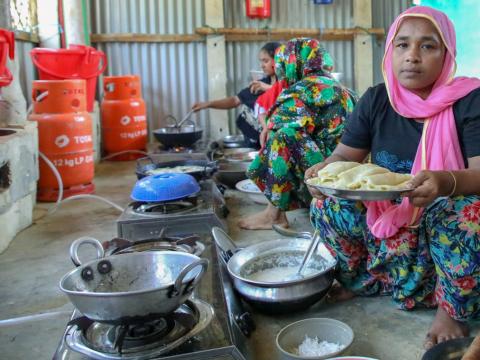World Vision community kitchens are the “heart of the home” for refugee mothers

“Please have one, take a taste,” says Setara, proudly holding out a platter of warm, freshly made crepes. “I learned how to make these here in the community kitchen just this week.”
Laughter and chatter fills the humid morning air as Setara and a dozen neighbours cook together at one of the 42 World Vision Community Kitchen and Learning Centres supported by World Vision New Zealand and the Disasters Emergency Committee, U.K. Stirring vats of fragrant rice and woks of simmering sauce, they chitchat about family and the latest news.
Opened late last year, the kitchens were originally built to prevent fires in the camps and help stop deforestation as refugees decimated forests in search of cooking fuel. Most families cook over open fires in their small plastic tarp-and-bamboo shelters. They burn anything they can find—wood, old clothes, plastic bottles and street garbage. This poses a deadly fire hazard in the overcrowded tinder-box camps. It’s also a severe health risk as children and adults inhale the toxic fumes inside their homes. Many children complain of eye infections and coughs.
Today, World Vision’s community kitchens are becoming the “heart of the home” for the 1,050 refugee mothers who prepare meals for their families here each day on the two-burner gas stoves.
“The kitchen is very helpful,” says Setara. “It saves us money because we don’t have to buy firewood. I have more money to buy food from the market and other necessary things for my children.”
In addition to having a safe, convenient place to cook, Setara is learning new skills at the community kitchen. “We learned how to make pastries like patisapta, a cake made with flour and sweet rice pudding, says Setara. “We are also making singara, a snack made with flour and spiced potatoes, and jilapi, a simple flour and sugar sweet and nimki, a popular biscuit. If we can learn how to make a few more things, like sweetmeat and curd, we can sell them in our local markets. Those pastries will bring in money.”
Setara and her neighbours are eager to earn an income. Legally, refugees are not allowed to work in the camps, but they need cash to buy daily necessities. Of the 232,000 families in the camps, more than 32,000 are headed by women—most of whom are widows. Never having worked outside their homes in Myanamar, they are trying to find ways to cope as the family breadwinners.
“At the kitchen, we discuss how we can improve our situation and have a better life,” says Setara. “We talk about how we could work together and earn money. We really want to do this.”
At the community kitchen, Setara and her neighbours participate in weekly classes on basic nutrition, health and hygiene practices and kitchen gardening. World Vision distributed packages of seeds—spinach, pumpkin, gourds, okra, and red amaranth—that the women can plant outside their shelters.
Increasingly, the kitchens are becoming community hubs where women can cook, learn new skill and find the support they need. The Rohingyas’ conservative social and cultural norms restrict women’s movement. The kitchens are one of the few places in the camps where women and adolescent girls are allowed to go by themselves. The centres provide camaraderie and comfort in a safe, celebrated space that the women can call their own here in the world’s largest refugee camp.
“After cooking together in the kitchen, we talk together about our problems,” confides Setara. “If we have any worries, we share them with each other. If anything bad happens to us, this kitchen is a place where we can talk about it freely. We try to share each other’s burdens.”
Domestic violence is one of those burdens. According to a recent report, domestic violence continues to be one of the most common gender-based violence (GBV) concerns facing Rohingya women and girls. Some 71 percent of the reported GBV incidents occurred in the survivors’ home, and 74 percent of the total reported cases were perpetrated by intimate partners.
World Vision recently started holding GBV awareness and prevention classes in the community kitchens for the women, as well as their husbands and families.
“We want the community kitchens to be integrated service centres where women can learn new skills and share them with others,” says World Vision programme officer, Ruby Areng.